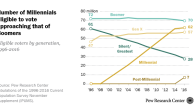
Millennials approach Baby Boomers as America’s largest generation in the electorate
As of November 2016, an estimated 62 million Millennials were voting-age U.S. citizens – moving closer in number to the 70 million Baby Boomers.
Numbers, Facts and Trends Shaping Your World
All
Publications
As of November 2016, an estimated 62 million Millennials were voting-age U.S. citizens – moving closer in number to the 70 million Baby Boomers.
Our interactive graphic compares the generations today and in the years that each generation was young (ages 18 to 33) to demonstrate this sea change in the activities and experiences of young adults that has occurred over the past 50 years.
Our analysis finds that Millennials stand apart from the young adults of the Silent generation when it comes to education, employment and home life.
While Millennials make up 32% of all U.S. adults, they account for roughly half of American Muslim adults. Read five facts about Muslim Millennials.
Millennials trail Baby Boomers and Generation Xers in the number of households they head. But Millennial-run households represent the largest group in some key categories, such as the number in poverty or the number headed by a single mother.
Many Americans say they’d benefit from help in finding trustworthy information online, and about eight-in-ten adults say public libraries can help.
Generation Zers, Millennials and Generation Xers cast 69.6 million votes in 2016, a slight majority of the 137.5 million total votes cast.
About half of U.S. Millennials have visited a public library or bookmobile in the past year.
Four-in-ten Millennial workers ages 25 to 29 had completed at least a bachelor’s degree in 2016, compared with 32% of Generation X workers and smaller shares of the Baby Boom and Silent generations when they were in the same age range.
Through both recession and recovery, the share of young adults living in their parents’ home continues to rise. As of 2016, 15% of 25- to 35-year-old Millennials were living in their parents’ home.
Notifications